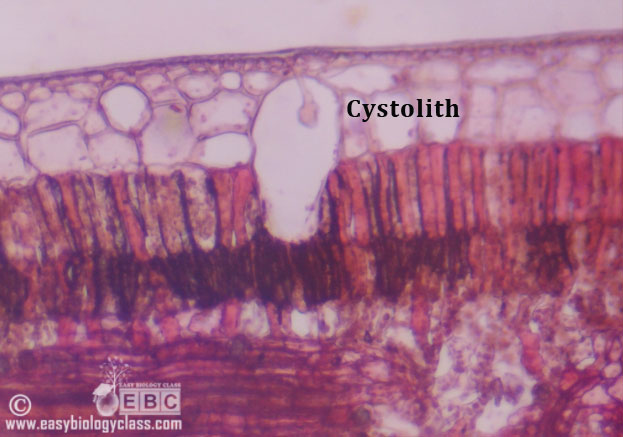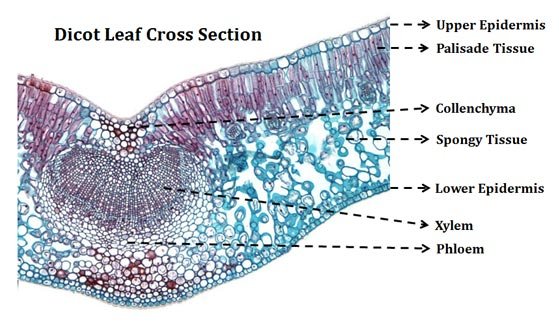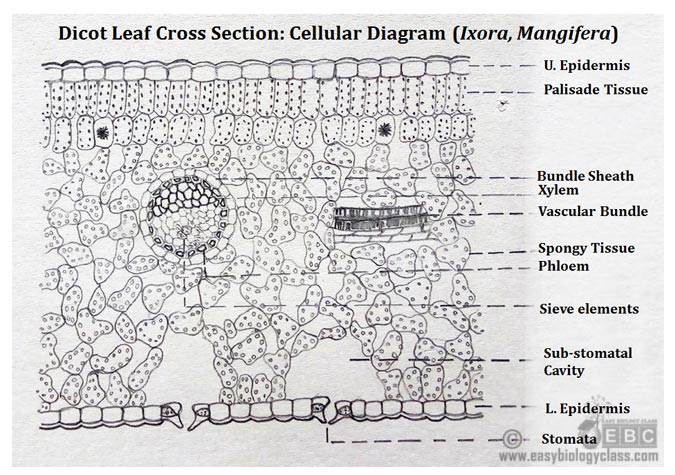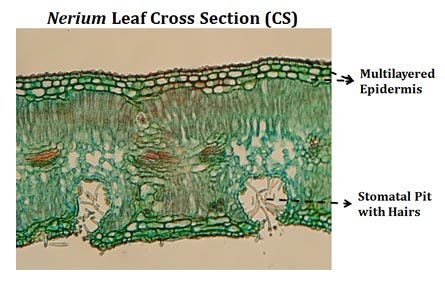Leaves are structurally well adapted to perform the photosynthesis, transpiration and gaseous exchange. A leaf composed of: (1). Leaf blade: also called leaf lamina is the flattened expanded part of the leaf chiefly composed of mesophyll tissue and vascular bundles and (2). Petiole: the stack of leaf . Based on the differentiation of mesophyll, two categories of leaves are present among Angiosperms, namely (1). Dorsiventral Leaf and (2). Isobilateral Leaf. The present article discusses the anatomy of a Dorsiventral Leaf with and examples of TS of Dicot Leaf.
(1). Dorsiventral Leaf
Ø Also called bifacial leaf.
Ø They have anatomically different dorsal and ventral sides.
Ø The mesophyll tissue is differentiated into upper palisade and lower spongy tissues.
Ø Dorsiventral leaves are common among Dicots.
Ø Dorsiventral leaves are usually hypostomatic or rarely epistomatic.
Ø Hypostomatic leaf: stomata present only on the lower surface of the leaf.
Ø Epistomatic leaf: stomata present only on the upper surface of the leaf.
(2). Isobilateral Leaf
Ø Also called equifacial leaf.
Ø They have anatomically similar dorsal and ventral portions.
Ø The mesophyll tissue is undifferentiated.
Ø Isobilateral leaves are commonly found in monocots, particularly in grasses.
Ø Leaves are usually amphistomatic.
Ø Amphistomatic: stomata distributed on both upper and lower surface of the leaf.
TS of Dicot Leaf
Ø The internal structure of dicot leaf can be studied by a cross section through the leaf lamina.
Ø Anatomically a dicot leaf shows the following tissue zones:
(1). Upper Epidermis
(2). Mesophyll
(a). Palisade Tissue
(b). Spongy Tissue
(3). Vascular Tissue
(4). Midrib
(5). Lower Epidermis
Upper Epidermis
Ø Upper epidermis composed of a single layer of parenchymatous cells.
Ø Outer wall of the cells are thick and covered with a thick layer of cuticle.
Ø Epidermal cells are devoid of chloroplasts.
Ø Stomata are generally absent in the upper epidermis.
Ø In floating aquatic plants such as Nymphaea, the stomata are present on the upper epidermis.
Ø Epidermal hairs or trichomes are also present on the epidermis.
Ø Sometimes possess glandular hairs with secretory contents.
Ø Epidermal cells in the members of Urticaceae, Cucurbitaceae, Moraceae, Acanthaceae possess cystoliths (a calcium carbonate crystal).
Ø Cystolith containing cells are comparatively larger than other epidermal cells and are called lithocytes.
Ø Upper epidermis is multilayered in some plants such as in the members of the family Moraceae, Piperaceae, Begoniaceae.

Cystolith of Ficus Leaf
Mesophyll
Ø Mesophyll is the chloroplast containing portion of the leaf.
Ø In dicot leaves the mesophyll is differentiated into two zones.
(a). Palisade Tissue
(b). Spongy Tissue
(a). Palisade Tissue:
Ø Palisade tissue is present on the upper (dorsal or adaxial) surface of the leaf.
Ø Composed of usually one or two layers of cells.
Ø Cells are compactly packed without any intercellular spaces.
Ø Cells are columnar
Ø Contain large number of chloroplasts.
Ø The main function of palisade tissue is to perform the photosynthesis.

(b). Spongy Tissue
Ø Spongy tissue occupies below the palisade tissue.
Ø Cells are loosely arranged and irregularly shaped.
Ø Large number of intercellular spaces is present.
Ø Cells of the spongy tissue contain chloroplasts; however, the amount of chloroplasts is less than that of palisade tissue.
Ø Cells of spongy tissue are in contact with the atmosphere through the stomata.
Ø The main function of spongy tissue is to perform gaseous exchange. (absorption of CO2 and release of O2 and water vapour)
Ø In some leaves (Hakea) the mesophyll cells possess osteosclereids for mechanical support.
Ø In Nymphaea, mesophyll cell possesses asterosclereids for mechanical support.
Vascular Tissue
Ø Vascular tissue in the leaves is called vein.
Ø The pattern of vein arrangement is called venation.
Ø Dicots have reticulate (net like) venation.
Ø The net like vascular system of dicot leaf enclosing a small area of mesophyll tissue is called areoles.
Ø Vascular tissue is irregularly distributed in the mesophyll.
Ø Each vascular bundle is surrounded by parenchymatous bundle sheath or border parenchyma.
Ø In C4 plants, the bundle sheath cells contain chloroplasts.
Ø Bundle sheath may have extensions which may reach both the upper and lower epidermal layers.
Ø In the vascular bundle, the xylem is located towards the upper side and the phloem is located towards the lower side.
Ø Vascular bundles are conjoint, collateral and closed (cambium absent).
Ø Xylem composed of vessels, tracheids, fibres and parenchyma
Ø Phloem composed of sieve tubes, companion cells and phloem parenchyma.

Midrib
Ø Midrib is the exact middle portion of the leaf blade.
Ø The mesophyll tissue is absent in the midrib region.
Ø Midrib portion is occupied by vascular tissue, parenchyma and collenchyma.
Ø Vascular tissue composed on xylem and phloem.
Ø Xylem is located towards adaxial side and the phloem is located towards the abaxial side
Ø Cambium sometimes present in the midrib vascular bundles
Ø The midrib gives off many lateral vascular strands which supply the leaf lamina.
 Lower Epidermis
Lower Epidermis
Ø The lower epidermis is similar to the upper epidermis.
Ø Usually composed of a single layer of compactly packed parenchymatous cells.
Ø Cuticle present, but relatively thinner than that of upper epidermis.
Ø Numerous stomata are present on the lower epidermis.
Ø Stomata are surrounded by two guard cells and two to many subsidiary cells.
Ø The nature of stomata and number and arrangement of subsidiary cells varies in different plants.
Ø The stomata open inside into a sub-stomatal cavity.
Ø In xerophytic plants, the stomata are sunken type for reducing the rate of transpiration.
Ø In Nerium, a xerophyte, the stomata are situated in pits with many hairs.
Ø In some succulents, the lower epidermis is multilayered.
You may also like NOTES in...
BOTANY BIOCHEMISTRY MOL. BIOLOGY
ZOOLOGY MICROBIOLOGY BIOSTATISTICS
ECOLOGY IMMUNOLOGY BIOTECHNOLOGY
GENETICS EMBRYOLOGY PHYSIOLOGY
EVOLUTION BIOPHYSICS BIOINFORMATICS
Practical identification points of Dicot Leaf (Example: Ixora, Hibiscus, Mangifera, Ficus)
Ø Reticulate venation
Ø Dorsiventral leaf
Ø Mesophyll is differentiated into upper palisade and lower spongy tissue
Ø Vascular bones with parenchymatous bundle sheet
Review Questions
1. With a suitable labeled diagram, explain the anatomy of a dicot leaf.
2. What are differences between dicot and monocot leaf?
3. What is meant by venation?
4. What are areoles?
5. What is leaf blade?
6. What is petiole?
7. What is meant by dorsiventral leaf? Give example
8. What is meant by isobilateral leaf? Give example
9. Differentiate dorsiventral and isobilateral leaf.
10. Define epistomatic leaf. Give example
11. Define hypostomatic leaf. Give example
12. Define amphistomatic leaf. Give example
13. What are lithocytes?
14. How the upper epidermis of a dicot leaf is different from its lower epidermis?
15. Explain the structure of vascular tissue in dicot leaf.
You may also like…
@. Anatomy of Dicot Stem-Primary Structure
@. Anatomy of Dicot Root- Primary Structure
You may also like...
NOTES QUESTION BANK COMPETITIVE EXAMS.
PPTs UNIVERSITY EXAMS DIFFERENCE BETWEEN..
MCQs PLUS ONE BIOLOGY NEWS & JOBS
MOCK TESTS PLUS TWO BIOLOGY PRACTICAL
